
Languedoc - an area guide
An inside guide to the Languedoc, the area and its sights
- Explore France ►
- Essential pages
- Travel in France
- Where to go
- What to see and do
About-France.com
- the connoisseur's guide to France
Now part of the Occitanie
region, the Languedoc-Roussillon area, popularly known as the
Languedoc, is the central region of the south of
France; it includes the western Mediterranean coast of France,
stretching from the Rhone valley in the east, to the Spanish border in
the south west, and comprises five departments: four of these
are Mediterranean coastal departments: the Gard (30), the
Hérault (34), the Aude (11) and the Eastern Pyrenees or Pyrénées
orientales (66). The fifth department is rather different, being the
upland department of Lozère (48), which forms the southern bastion of
the Massif Central
Discover
Languedoc-Roussillon
| Page index ► | Regional overview | Main tourist attractions |
| Hotels in Languedoc | Further details |
A short guide to Languedoc
Midi-Pyrénées into a new super-region that has taken the name "Occitanie" - a historical reference to the part of France where until the nineteenth century most people spoke varieties of Occitanian French, not the standard French of northern France.
Historically, the area known as "Languedoc", covered a larger part of southernFrance, indeed much of modern Occitanie and Provence. The name itself is a reference to the language(s) (Les langues d'oc - see below) spoken in this part of France in past centuries, ; Roussillon is a much smaller area, being more or less the area covered by the Eastern Pyrenees department. Roussillon, in the past, was the northern part of Catalonia, and people here still speak Catalan as well as French.
The main city of Languedoc-Roussillon is Montpellier, a thriving modern city in the Hérault, with a historic centre; other major cities in the region are Nimes, Narbonne, Sete and Perpignan.
Unlike Provence, Languedoc has a considerable coastal plain, and except in the department of Eastern Pyrenees, much of the coastal area is flat. In the past, the land was swampy and plagued with mosquitoes, which is why tourism did not develop here in the 19th century, as it did on the coast further east. However, the swamps were drained long ago, and the mosquitoes brought under control, leading to the tourist development of this long coastline as from the nineteen-sixties.
Today, the coast of Languedoc is characterised by long sandy beaches, often with plenty of space, and a modern tourist infrastructure, with twentieth-century resorts such as Cap d'Agde, Palavas, or Narbonne Plage. The brash developments of the sixties have had time to mature, parts of the coastline have been recovered for more environmentally sensitive tourism development; and among the quite densely built-up resort areas, there are attractive bits of coastline and hinterland. However, as a general rule, the areas within 20 km of the coast have been extensively developed for tourism in the last forty years.
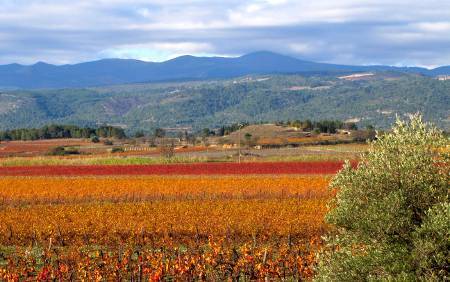
Autumn lingers in Languedoc. November colours in the vineyards of the Minervois, north of Narbonne, with the garrigue and hills of high Languedoc behind
Those who do not want to spend their holidays being char-grilled on a beach will perhaps prefer to discover the old Languedoc, away from the cities and the immediate coastal strip. Inland Languedoc is a beautiful area, characterised by vineyards and "garrigue", arid rocky Mediteranean hills with their vegetation of scrub, aromatic bushes and occasional fields. North and northeast of Montpellier, the valleys, more wooded and rural, give way to the Cevennes hills, the southeastern peaks of the Massif Central.
 The area has a lot of historic cities,
such as Nimes
with its superb Roman remains, the famous walled city of
Carcassonne,
the former Roman provincial capital of Narbonne, and other
smaller ancient cities, such as Agde
.
The area has a lot of historic cities,
such as Nimes
with its superb Roman remains, the famous walled city of
Carcassonne,
the former Roman provincial capital of Narbonne, and other
smaller ancient cities, such as Agde
. The Pyrenees, forming a natural land barrier between France and Spain, are a beautiful range of high mountains, wooded on their lower slopes, but offering good mountain and hill walking higher up - not to mention the attraction of day trips into Spain. The coastline where they meet the sea is unlike the rest of the Languedoc coast, and is characterised by old coastal villages such as Banyuls and Collioure, rocky cliffs and small coves. The villages on the Pyrenean coastline can be reached directly by train.
Access to Languedoc : by TGV from Paris Gare de Lyon, or from Lille; train from many cities, motorway from Paris, Lille, Strasbourg, Nancy, Lyon, Geneva. There are airports at Béziers, Nimes, Montpellier, Carcassonne and Perpignan, with low-cost flights from the UK, Belgium and Holland..
The Origin of the name "Languedoc":
The "Langue d'oc" was the version of French spoken in the south of the country, and Languedoc referred to the part of France in which the "language of Oc" was spoken. "Oc" (from the Latin ac ) was the word for "yes" in this part of France, at a time when people in the north of France said "oeuil", an old French word that has become modern French "oui". Today, the "langue d'oc" survives in the many patois still spoken by a few people in rural areas of this part of France.
The new regional name Occitanie is another reference to the historic language of "Oc".
Detailed map of Languedoc:
Click here, and drag the map to cover the Languedoc area. then zoom in or out.
Discover the Cevennes. Take the About-France.com recommended route from Mende, in the Lozère, down to the Camargue
Main tourist attractions in Languedoc Roussillon

The ramparts of Carcassonne ©

The Canal du Midi

The Pont du Gard, near Nimes
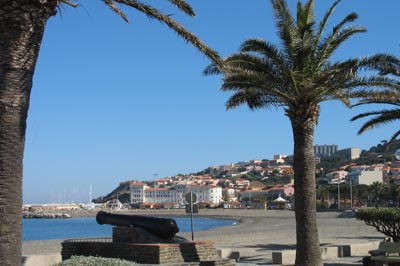
Banyuls sur Mer - Pyrénees orientales:
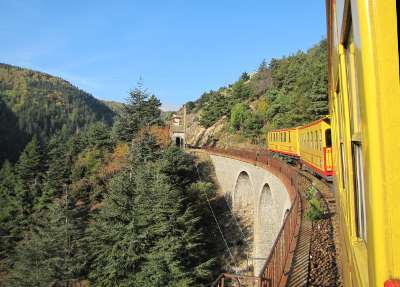
The Petit train jaune scenic railway, near Perpignan
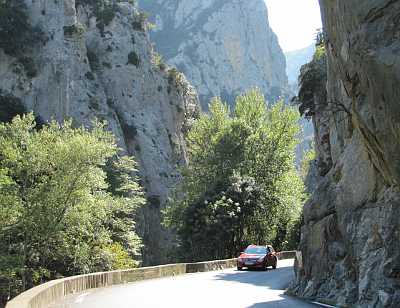
Impressive Aude gorge, in the Pyrenees
Text & photos Copyright © About-France.com 2008 - 2024
except for Pont du Gard - by W Staudt, licence creative commons
Attractions covering more than one department:
- Le Canal du Midi - (34,11) world's oldest commercial canal, built in 17th century. From Agde to Carcassonne, - and beyond to the Atlantic. Canal with shaded cycleway and footpath. UNESCO world heritage site.
- Les Cévennes: (30, 34) beautiful mountains, with steep wooded valleys. National Park area. Impressive caves .
- The Coast: (30, 34, 11, 66) plenty of beaches, marinas and small ports. Miles of sandy beaches, crowded in parts at times, but also including long expanses of fairly empty sand.
- Gorges du Tarn (12 - 48) dramatic and deep gorge of the river Tarn, through the limestone rock of the Causses.
By
department East to West
Gard
- Bagnols sur Cèze (30) Musée Albert André. Fine collection of late 19th century French art, including works by Bonnard, Matisse, Marquet, Signac, Jongkind, Rodin and more.
- Nimes: (30) old city with narrow streets, and remarkable Roman remains, including the Arena and the Maison Carrée
- Le Pont du Gard: (30) UNESCO World Heritage site, impressive Roman aqueduct, just north east of Nimes.
- Aigues Mortes: (30) fully walled bastide town near the coast, once a port from which the Crusaders set forth. See walled cities
- The western part of the Camargue
- Train à vapeur des Cévennes: (30) Cevennes steam railway. From Anduze
- Uzès. Attractive small town north of Nimes, famous for the Castle of the Dukes, and the Fenestrelle tower, a unique circular romanesque tower dating from the 12th century. The town also has the Haribo sweets museum.
- The Cevennes mountains, and National Park. A beautiful area of wooded hills and valleys, with open summits culminating in the Mont Lozère at 1699 metres (5574 ft) above sea level.
Lozère
- La Lozère: (48) sparsely-populated upland area, with a dry climate, mountains, spruce forests and gorges...
Hérault
- Montpellier: (34) regional capital, with old centre, the Musée Fabre, churches and other sites.
- Agde : attractive old small city, old streets, market, cathedral, waterfront.
- Béziers: (34) traditional Languedoc city, with old streets, churches and gardens.
- St.Guilhen le Désert (34) - small medieval city with romanesque abbey and ruined castle. Also the nearby Grotte de la Clamouse: magnificent stalacmites and stalagtites.
- Sète: (34) fishing and commercial port. Old town, beaches, boat trips
Aude
- Narbonne: (11) former Roman city, once the regional capital, with an impressive cathedral, underground Roman grain-store, and canalside quays.
- Carcassonne: (11) UNESCO World Heritage site, a historic city encircled by medieval ramparts.
- Cathar country: a collection of fabulous medieval castles, veritable eagles nests perched on rocky crags, guarding over this once turbulent frontier region. Of special note are the castles of Quéribus and Puylaurens.
- Cathar country tourist train, departs from Rivesaltes near Perpignan, and rises to Axat in the Pyrenees.
- Sigean (11) African safari park: perhaps the best and the biggest (almost 700 acres) wildlife park in France (opened in 1974).
- The Canal du Midi: (34, 11) UNESCO World Heritage site, the world's oldest major canal, opened in 1681, linking the Mediterranean and the Atlantic
Pyrénées Orientales
- Céret (66): Museum of Modern Art, with works by Picasso, Chagall, Matisse, Braque etc.
- Collioure & Banyuls: (66) picturesque small towns almost on the Spanish border, where the Pyrenees meet the sea. Harbourside château at collioure.
- Le Train Jaune: (66) take the train up into the Pyrenees, from near Perpignan. Spectacular scenery, and open-top wagons.
- Medieval heritage : There is a rich heritage of Romanesque and Gothic architecture in the department, with highlights at Elne, Serrabona, St. Martin du Canigou, Saint Michel de Cuxa and the stunning 12th century frescoes at St. Martin de Fenollar, near Le Boulou.
Going further: Official Languedoc tourism site
About-France.com
Home
page - - Regions
- Maps of France
- Contact
Photo
top of page: view south from Cap Leucate, near Gruissan,
towards the Pyrenees

An entirely independent website, About-France.com is an affiliate partner of selected and relevent external websites, and may receive a small commission on sales or bookings generated on these sites
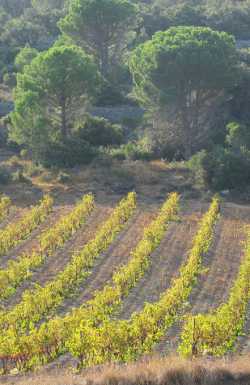
Languedoc is France's largest wine-producing region
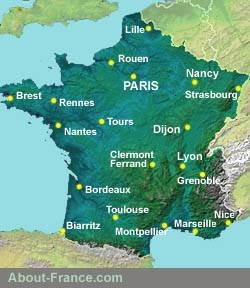
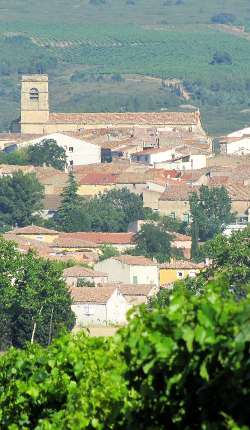
Typical Languedoc landscape,
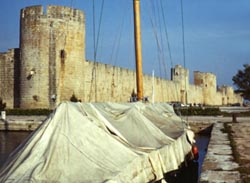
Aigues Mortes

Cathar castle at Quéribus
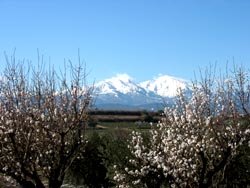
Spring comes early to Languedoc : blossom in February, and le Mont Canigou
Site
search
About-France.com
What are you looking for ? Where do you want to go?
About-France.com
What are you looking for ? Where do you want to go?

An entirely independent website, About-France.com is an affiliate partner of selected and relevent external websites, and may receive a small commission on sales or bookings generated on these sites

Languedoc is France's largest wine-producing region


Typical Languedoc landscape,

Aigues Mortes

Cathar castle at Quéribus

Spring comes early to Languedoc : blossom in February, and le Mont Canigou
